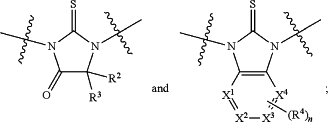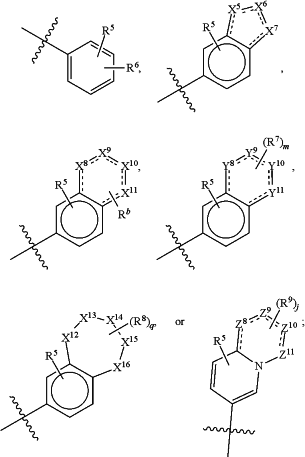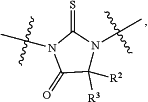| CPC C07D 471/04 (2013.01) [C07D 401/14 (2013.01); C07D 403/10 (2013.01); C07D 405/14 (2013.01); C07D 413/10 (2013.01)] | 20 Claims |
|
1. A compound of Formula (I) or a pharmaceutically acceptable salt thereof,
 wherein,
T is selected from the group consisting of CH and N;
R1 is selected from the group consisting of hydrogen, halogen, C1-12 alkyl, and halogen-substituted C1-12 alkyl;
the ring A is selected from the group consisting of
 R2 and R3 are each independently selected from C1-12 alkyl, or R2 and R3 are connected to each other to form a 3- to 6-membered cycloalkyl together;
X1, X2, X3, and X4 are each independently selected from the group consisting of CH and N, and at least one of them is N;
n is 0, 1, 2, or 3;
each R4 is independently selected from C1-12 alkyl;
the ring B is
 R5 is selected from the group consisting of hydrogen, C1-12 alkyl, C1-12 alkoxy, and halogen;
R6 is selected from C1-12 alkylaminocarbonyl;
one of X5, X6, and X7 is N(—Ra), and the others are CH or N;
Ra is selected from 5-membered heterocycloalkyl, wherein the heterocycloalkyl is optionally substituted by halogen, C1-4 alkyl, C2-4 alkenyl, C2-4 alkynyl, 3- to 6-membered cycloalkyl, 3- to 6-membered heterocycloalkyl, C1-4 alkoxy, hydroxyl, or amino;
X8, X9, X10, and X11 are each independently selected from the group consisting of CH, C(═O), N, and NH, and three of X8, X9, X10, and X11 are C(═O), N, and NH, respectively;
Rb is selected from C1-12 alkyl, wherein the C1-12 alkyl is optionally substituted by halogen;
Y8, Y9, Y10, and Y11 are each independently selected from the group consisting of CH and N, and at least two of Y8, Y9, Y10, and Y11 are N;
m is 0, 1, or 2;
each R7 is independently selected from the group consisting of halogen, C1-12 alkyl, hydroxyl, C1-12 alkoxy, amino, 3- to 10-membered cycloalkyl, 3- to 10-membered heterocycloalkyl, 5- to 10-membered heteroaryl, and C1-12 alkylamino, wherein the C1-12 alkyl, 3- to 10-membered cycloalkyl, 3- to 10-membered heterocycloalkyl, 5- to 10-membered heteroaryl, or C1-12 alkylamino is optionally substituted by halogen, and wherein the hydroxyl is substituted by: —C1-12 alkyl-OH, —C1-12 alkyl-(3- to 10-membered heterocycloalkyl), —C1-12 alkyl-S(═O)2Rc, —C1-12 alkyl-NRdRe, —C1-12 alkyl-C(═O)NRfRg, —C1-12 alkyl-(3- to 10-membered cycloalkyl) optionally substituted by halogen or hydroxyl, or 3- to 10-membered heterocycloalkyl optionally substituted by halogen or hydroxyl;
Z8, Z9, Z10, and Z11 are each independently selected from the group consisting of CH, C(═O), and N;
j is 0, 1, or 2;
each R9 is independently selected from the group consisting of halogen, C1-12 alkyl, C1-12 alkoxy, and hydroxyl, wherein the C1-12 alkyl is optionally substituted by halogen or C1-12 alkoxy, and wherein the hydroxyl is optionally substituted by: —C1-12 alkyl-O—C1-12 alkyl, —C1-12 alkyl-OH, or —C1-12 alkyl-C(═O)NRfRg;
Rc, Rd, Re, Rf, and Rg are each independently selected from the group consisting of hydrogen, C1-12 alkyl, 3- to 10-membered cycloalkyl, 3- to 10-membered heterocycloalkyl, C1-12 alkoxy, hydroxyl, and amino;
two of X12, X13, X14, X15, and X16 are NH and C(═O), respectively, and the others are CH2, O, or S;
q is 0, 1, 2, 3, or 4; and
each R8 is independently selected from the group consisting of halogen, C1-12 alkyl, hydroxyl, amino, 3- to 10-membered cycloalkyl, C1-12 alkoxy, 3- to 10-membered heterocycloalkyl, and C1-12 alkylamino;
provided that: when the ring A is selected from
 the ring B is not
 and when R7 is selected from C1-12 alkoxy, R7 substitutes the hydrogen on Y9, Y10, or Y11.
|